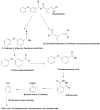Enhanced Cypermethrin Degradation Kinetics and Metabolic Pathway in Bacillus thuringiensis Strain SG4
- PMID: 32046050
- PMCID: PMC7074683
- DOI: 10.3390/microorganisms8020223
Enhanced Cypermethrin Degradation Kinetics and Metabolic Pathway in Bacillus thuringiensis Strain SG4
Abstract
Cypermethrin is popularly used as an insecticide in households and agricultural fields, resulting in serious environmental contamination. Rapid and effective techniques that minimize or remove insecticidal residues from the environment are urgently required. However, the currently available cypermethrin-degrading bacterial strains are suboptimal. We aimed to characterize the kinetics and metabolic pathway of highly efficient cypermethrin-degrading Bacillus thuringiensis strain SG4. Strain SG4 effectively degraded cypermethrin under different conditions. The maximum degradation was observed at 32 °C, pH 7.0, and a shaking speed of 110 rpm, and about 80% of the initial dose of cypermethrin (50 mg·L-1) was degraded in minimal salt medium within 15 days. SG4 cells immobilized with sodium alginate provided a higher degradation rate (85.0%) and lower half-life (t1/2) of 5.3 days compared to the 52.9 days of the control. Bioaugmentation of cypermethrin-contaminated soil slurry with strain SG4 significantly enhanced its biodegradation (83.3%). Analysis of the degradation products led to identification of nine metabolites of cypermethrin, which revealed that cypermethrin could be degraded first by cleavage of its ester bond, followed by degradation of the benzene ring, and subsequent metabolism. A new degradation pathway for cypermethrin was proposed based on analysis of the metabolites. We investigated the active role of B. thuringiensis strain SG4 in cypermethrin degradation under various conditions that could be applied in large-scale pollutant treatment.
Keywords: Bacillus thuringiensis; bioaugmentation; biodegradation; cypermethrin; kinetics; metabolic pathway.
Conflict of interest statement
The authors declare no conflict of interest. The funders had no role in the design of the study; in the collection, analyses, or interpretation of data; in the writing of the manuscript, or in the decision to publish the results.
Figures





References
Grants and funding
LinkOut - more resources
Full Text Sources

